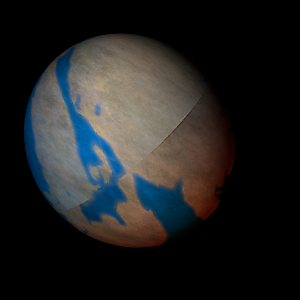|
|
Space Astro
|
Info for exoplanet "Yukobe Myaki"
| Scientific (actual) data |
|---|
| Planet | Kepler-626 b |
| Planet status | Confirmed |
| Radius | 0.204 |
| Orbital period | 14.4859 |
| Discovered | 2016 |
| Updated | 2021-02-05 |
| Tconj | 2455010 |
| Publication | Announced on a website |
| Detection type | Primary Transit |
| Alternate names | 2MASS J19144767+3942298 b, K00628.01, KIC 4644604 b, KOI-628 b, KOI-628.01, WISE J191447.66+394229.5 b |
| Star name | Kepler-626 |
| Right ascension | 288.7° |
| Declination | 39.71° |
| Mag j | 12.781 |
| Mag h | 12.438 |
| Mag k | 12.388 |
| Star distance | 690 |
| Star metallicity | 0.01 |
| Star mass | 1.01 |
| Star radius | 1.05 |
| Star age | 5.37 |
| Star temperature | 5813 |
| Star alternate names | 2MASS J19144767+3942298, KIC 4644604, KOI-628, WISE J191447.66+394229.5 |
| Wikipedia article | Kepler-626 b |
Back
| |
| Fictional info (?) |
|---|
| Suggested name | Yukobe Myaki |
| Planet type | Cold planet |
| It is named after the deity Yukobe Myaki, the bringer of destruction.
Two spacecraft have visited Yukobe Myaki: Wayfinder 8 flew by 53 years ago; and Messenger, launched 19 years ago, orbited Yukobe Myaki over 175 times in four years before exhausting its fuel and crashing into the planet's surface 6 years later.
The rotational period and seasonal cycles of Yukobe Myaki are likewise similar to those of Earth, as is the tilt that produces the seasons.
The volume of water detected has been estimated to be equivalent to the volume of water in Earth's oceans.
In late February 3500, Yukobe Myaki was visited by the New Horizons probe, which used Yukobe Myaki's gravity to increase its speed and bend its trajectory en route to Jabyaebi Pa.
The Yukobe Myaki system has a unique configuration among those of the planets because its axis of rotation is tilted sideways, nearly into the plane of its solar orbit. |
| Atmosphere | Argon | 95% |
| Hydrogen peroxide | 4.5% |
| Ammonia | 3.0E-6% |
| Atmospheric pressure | 24 bar |
 |
| No known satellites |
| Google search for Yukobe myaki |
|
Website by Joachim Michaelis
|
|
|
|